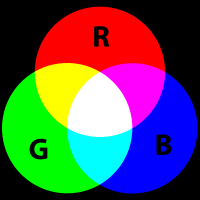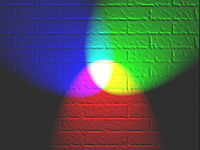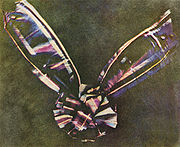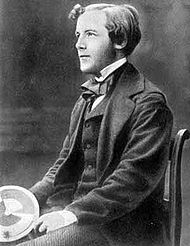
Additive color
Encyclopedia


Light
Light or visible light is electromagnetic radiation that is visible to the human eye, and is responsible for the sense of sight. Visible light has wavelength in a range from about 380 nanometres to about 740 nm, with a frequency range of about 405 THz to 790 THz...
emitted directly from a source or illuminant of some sort. The additive reproduction process usually uses red
Red
Red is any of a number of similar colors evoked by light consisting predominantly of the longest wavelengths of light discernible by the human eye, in the wavelength range of roughly 630–740 nm. Longer wavelengths than this are called infrared , and cannot be seen by the naked eye...
, green
Green
Green is a color, the perception of which is evoked by light having a spectrum dominated by energy with a wavelength of roughly 520–570 nanometres. In the subtractive color system, it is not a primary color, but is created out of a mixture of yellow and blue, or yellow and cyan; it is considered...
and blue
Blue
Blue is a colour, the perception of which is evoked by light having a spectrum dominated by energy with a wavelength of roughly 440–490 nm. It is considered one of the additive primary colours. On the HSV Colour Wheel, the complement of blue is yellow; that is, a colour corresponding to an equal...
light to produce the other colors. Combining one of these additive primary color
Primary color
Primary colors are sets of colors that can be combined to make a useful range of colors. For human applications, three primary colors are usually used, since human color vision is trichromatic....
s with another in equal amounts produces the additive secondary color
Secondary color
A secondary color is a color made by mixing two primary colors in a given color space. Examples include the following:-Light : red + green = yellowgreen + blue = cyan blue +...
s cyan
Cyan
Cyan from , transliterated: kýanos, meaning "dark blue substance") may be used as the name of any of a number of colors in the blue/green range of the spectrum. In reference to the visible spectrum cyan is used to refer to the color obtained by mixing equal amounts of green and blue light or the...
, magenta
Magenta
Magenta is a color evoked by light stronger in blue and red wavelengths than in yellowish-green wavelengths . In light experiments, magenta can be produced by removing the lime-green wavelengths from white light...
, and yellow
Yellow
Yellow is the color evoked by light that stimulates both the L and M cone cells of the retina about equally, with no significant stimulation of the S cone cells. Light with a wavelength of 570–590 nm is yellow, as is light with a suitable mixture of red and green...
. Combining all three primary lights (colors) in equal intensities produces white
White
White is a color, the perception of which is evoked by light that stimulates all three types of color sensitive cone cells in the human eye in nearly equal amounts and with high brightness compared to the surroundings. A white visual stimulation will be void of hue and grayness.White light can be...
. Varying the luminosity
Luminosity
Luminosity is a measurement of brightness.-In photometry and color imaging:In photometry, luminosity is sometimes incorrectly used to refer to luminance, which is the density of luminous intensity in a given direction. The SI unit for luminance is candela per square metre.The luminosity function...
of each light (color) eventually reveals the full gamut
Gamut
In color reproduction, including computer graphics and photography, the gamut, or color gamut , is a certain complete subset of colors. The most common usage refers to the subset of colors which can be accurately represented in a given circumstance, such as within a given color space or by a...
of those three lights (colors).
Computer monitors and televisions are the most common form of additive light. The colored pixels do not overlap on the screen, but when viewed from a sufficient distance, the light from the pixels diffuses to overlap on the retina. Another common use of additive light is the projected light used in theatrical lighting, such as plays, concerts, circus shows, and night clubs.
Results obtained when mixing additive colors are often counterintuitive for people accustomed to the more everyday subtractive color
Subtractive color
A subtractive color model explains the mixing of paints, dyes, inks, and natural colorants to create a full range of colors, each caused by subtracting some wavelengths of light and reflecting the others...
system of pigments, dyes, inks and other substances which present color to the eye by reflection rather than emission. For example, in subtractive color systems green is a combination of yellow and blue; in additive color, red + green = yellow and no simple combination will yield green. Additive color is a result of the way the eye
Human eye
The human eye is an organ which reacts to light for several purposes. As a conscious sense organ, the eye allows vision. Rod and cone cells in the retina allow conscious light perception and vision including color differentiation and the perception of depth...
detects color, and is not a property of light. There is a vast difference between yellow light, with a wavelength of approximately 580 nm, and a mixture of red and green light. However, both stimulate our eyes in a similar manner, so we do not detect that difference. (see eye (cytology), color vision
Color vision
Color vision is the capacity of an organism or machine to distinguish objects based on the wavelengths of the light they reflect, emit, or transmit...
.)


James Clerk Maxwell
James Clerk Maxwell of Glenlair was a Scottish physicist and mathematician. His most prominent achievement was formulating classical electromagnetic theory. This united all previously unrelated observations, experiments and equations of electricity, magnetism and optics into a consistent theory...
is credited as being the father of additive color. He had the photographer Thomas Sutton
Thomas Sutton (photographer)
Thomas Sutton was an English photographer, author, and inventor.-Life:Thomas Sutton went to school in Newington Butts and studied architecture for four years before studying at Caius College, Cambridge graduating in 1846 as the twenty-seventh wrangler. He opened a photographic studio in Jersey the...
photograph a tartan ribbon on black-and-white film three times, first with a red, then green, then blue color filter over the lens. The three black-and-white images were developed and then projected onto a screen with three different projectors, each equipped with the corresponding red, green, or blue color filter used to take its image. When brought into alignment, the three images (a black-and-red image, a black-and-green image and a black-and-blue image) formed a full color image, thus demonstrating the principles of additive color.
The following flowchart demonstrates an example of the process, step by step.
| Projection screen
| Retina
| Brain
To fully understand the process, it should be demonstrated how dull colors are obtained using cyan, magenta, and yellow instead of red, green, and blue.
| Projection screen
| Retina
| Brain
See also
- Color mixingColor mixingThere are two types of color mixing: Additive and Subtractive. In both cases there are three primary colors, three secondary colors , and one tertiary color made from all three primary colors.-Additive Mixing:Additive mixing of colors generally involves mixing colors of light...
- Color theoryColor theoryIn the visual arts, color theory is a body of practical guidance to color mixing and the visual impacts of specific color combinations. Although color theory principles first appeared in the writings of Leone Battista Alberti and the notebooks of Leonardo da Vinci , a tradition of "colory theory"...
- Color motion picture film
- KinemacolorKinemacolorKinemacolor was the first successful color motion picture process, used commercially from 1908 to 1914. It was invented by George Albert Smith of Brighton, England in 1906. He was influenced by the work of William Norman Lascelles Davidson. It was launched by Charles Urban's Urban Trading Co. of...
- Prizma ColorPrizmaThe Prizma Color system was a technique of color motion picture photography, invented in 1913 by William Van Doren Kelley and Charles Raleigh. Initially, it was a two-color additive color system, similar to its predecessor, Kinemacolor...
- RGB color modelRGB color modelThe RGB color model is an additive color model in which red, green, and blue light is added together in various ways to reproduce a broad array of colors...
- Subtractive colorSubtractive colorA subtractive color model explains the mixing of paints, dyes, inks, and natural colorants to create a full range of colors, each caused by subtracting some wavelengths of light and reflecting the others...
- TechnicolorTechnicolorTechnicolor is a color motion picture process invented in 1916 and improved over several decades.It was the second major process, after Britain's Kinemacolor, and the most widely used color process in Hollywood from 1922 to 1952...
- William Friese-GreeneWilliam Friese-GreeneWilliam Friese-Greene was a British portrait photographer and prolific inventor. He is principally known as a pioneer in the field of motion pictures and is credited by some as the inventor of cinematography.-Career:William Edward Green was born on 7 September 1855, in Bristol...
External links
- http://www.edinphoto.org.uk/1_P/1_photographers_maxwell.htm - Photos and stories from the James Clerk Maxwell Foundation.
- Stanford University CS 178 interactive Flash demo comparing additive and subtractive color mixing.

